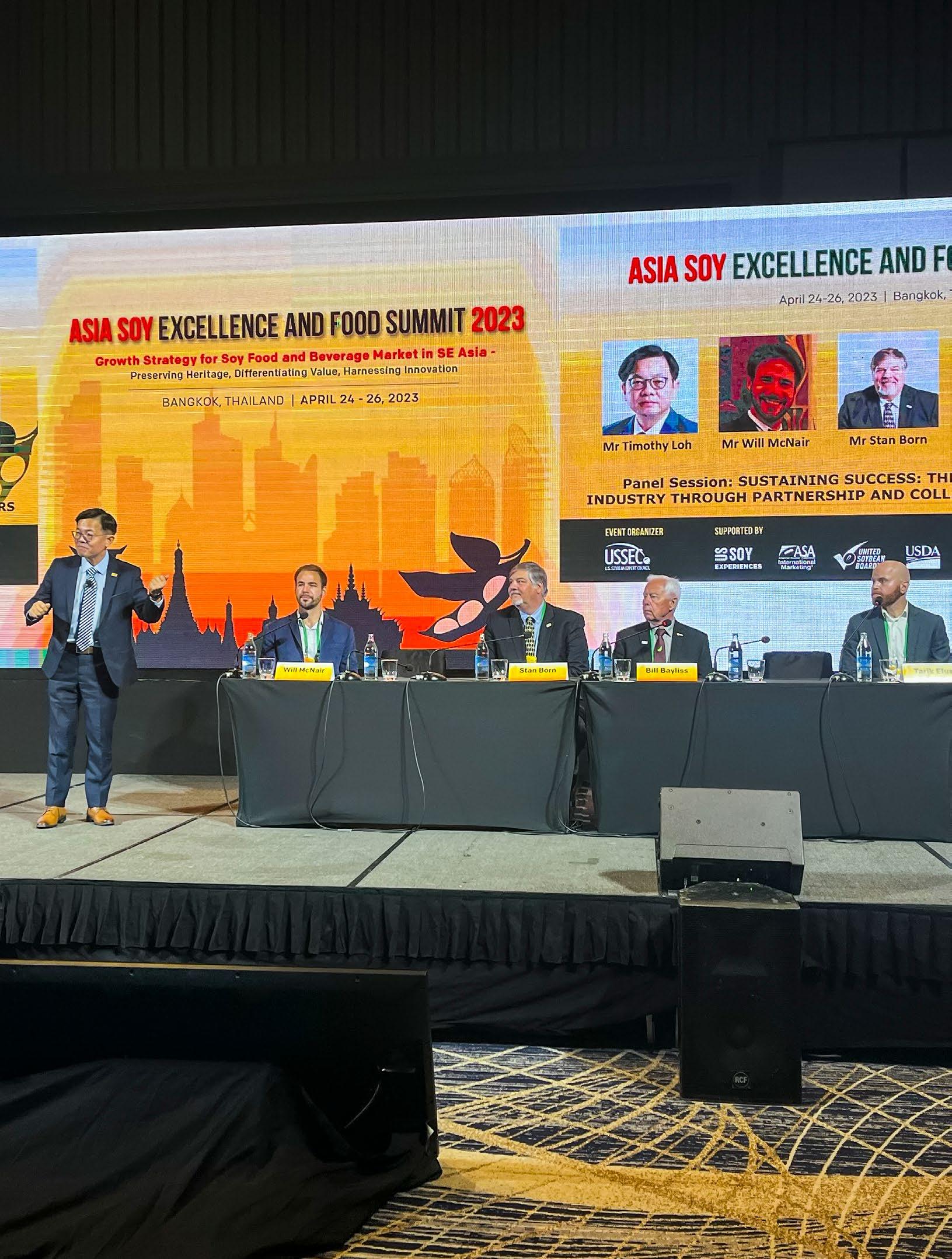
Corteva Young Leader Program p. 8
with Gunnar Lynum p. 16


Corteva Young Leader Program p. 8
with Gunnar Lynum p. 16

Whether it’s improving soybean meal to outperform the competition or promoting the sustainability of U.S. soy, the soy checkoff has been working behind the scenes to help farmers satisfy their customers’ needs. We’re looking inside the bean, beyond the bushel and around the world to keep preference for U.S. soy strong. And for U.S. soybean farmers like you, the impact is invaluable.
See more ways the soy checkoff is maximizing profit opportunities for farmers at unitedsoybean.org


COVER STORY: This April, Ohio Soybean Council (OSC) Vice Chairman Bill Bayliss and staff member Madi Layman took a brief trip to Asia to talk about Ohio and U.S. non-GMO soybeans for the first time since 2019. In collaboration with the U.S. Soybean Export Council, Bayliss and Layman attended the 2023 U.S. Food Bean Buyers Conference in Seoul, South Korea, and the Asia Soy Excellence and Food Summit in Bangkok, Thailand. Read more about their trip on pages 14 and 15.



Patrick Knouff
Ohio Soybean Association President Shelby County soybean farmer
Summer is here and that means we are coming up on one of the best times of the year — fair season! July can be a hectic month for many families with not only county fairs, but the Ohio State Fair as well! Through 4-H and open shows, my family has taken show pigs to our Shelby County Fair on top of the main event. There’s nothing quite like the stress of show-day preparations, but coming together and creating memories is what makes it all worth it at the end of the day. I hope to see all of you at this year’s Ohio State Fair from July 26–August 6 in Columbus, and as usual the Ohio Soybean Council (OSC) and Ohio Soybean Association (OSA) will have a presence every day at this year’s event. We will be set up once again at the Land & Living Exhibit in the Nationwide Donahey Ag and Hort building for the fair’s entirety, and we are excited to share new additions to our typical setup.
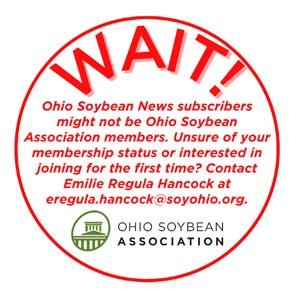
Not only do we have fair festivities to look forward to this summer, but we have another visit to Capitol Hill coming up in July for OSA. Several OSA board members will be heading to Washington, D.C., once again to continue to discuss the 2023 Farm Bill, biofuels, WOTUS and other key issues that will affect Ohio farmers. This is a monumentally important time and it is crucial that soybean farmers across the Buckeye State continue to have an impact on decisions that are made across the country.
This means that we need input from everyone to ensure that all voices are heard. One way to do that is through our membership. This is the best way to show your opinion and your support for our organization. We would not be able to do everything that we do to benefit Ohio soybean farmers without the support of all of our members. You can stay up to date on the latest news from OSA by becoming a member at SoyOhio.org/membership.
This edition of Ohio Soybean News is themed around International Marketing. The expansion of markets around the soybean industry is exciting, and one example of that is over in Asia. With travel restrictions lifting around the world, Ohio farmers were able to travel to South Korea and Thailand in May, proving the value that soybeans have globally. You can read more about that trip on pages 14 and 15.
I hope you enjoy the summer months with family and friends, and, as always, I appreciate all of the continued support that is offered to the Ohio Soybean Association.
Patrick Knouff

President
Patrick Knouff, Shelby County
Vice President
Rusty Goebel, Williams County
Treasurer
Bennett Musselman, Pickaway County
Secretary
Jeff McKanna, Hancock County
Chairman
Ryan Rhoades, Marion County
Trustees
David Clark, Warren County
Trish Cunningham, Union County
Justin Esselburn, Holmes County
Austin Heil, Hardin County
Caitlyn Heimerl, Industry Affiliate Ex-Officio
Jeff Magyar, Ashtabula County
Jeff McKanna, Hancock County
Derek Reusser, Holmes County
Andy Stickel, Wood County
Bob Suver, Clark County
Kerrick Wilson, Preble County
American Soybean Association
Board Representatives
Rusty Goebel
Scott Metzger
Ryan Rhoades
Staff Credits
Kirk Merritt - Publisher
Julia Brown - Editor
Eric Robinson - Staff Writer
Brent Warren - Art Director
Barry Falkner - Photo Quality/Proofer
Ohio Soybean News is published six times a year by the Ohio Soybean Association, 918 Proprietors Rd., Suite A, Worthington, OH 43085. Phone: 614-476-3100.
Comments and statewide news articles should be sent to the above address. Advertising space reservation must be made by the first of the month preceding publication. In consideration of the acceptance of advertisement, the agency and the advertiser must, in respect of the contents of the advertisement, indemnify and save the publisher harmless against any expense arising from claims or actions against the publisher because of the publication of the content of the advertisement.
For Advertising Sales Contact:
Matt Herman - (612) 812-5833 matt.herman@dtn.com
For Address Corrections Contact: Ohio Soybean News at 918 Proprietors Rd., Suite A, Worthington, OH 43085.
Web address: www.soyohio.org
E-mail: cdeboard@soyohio.org




WISHH connects Trade, Development & Food Security in Cambodia where fish account for 61% of households' animal protein intake. We cultivate trade with Cambodian feed mills that are buying U.S. soybean meal for the growing aquaculture industry that WISHH is developing. Our trade and development work makes protein more available in the country where 45% of Cambodians live in moderate or severe food insecurity.
Find out how WISHH’s three pillars of trade, development and food security cultivate new markets for U.S. Soy protein.




“I would tell anyone on the fence that if you’re leaning toward enrolling in a carbon program, go with the Soil and Water Outcomes Fund because of the team and the support they provide.”
- Adam Peters, Ohio farmer
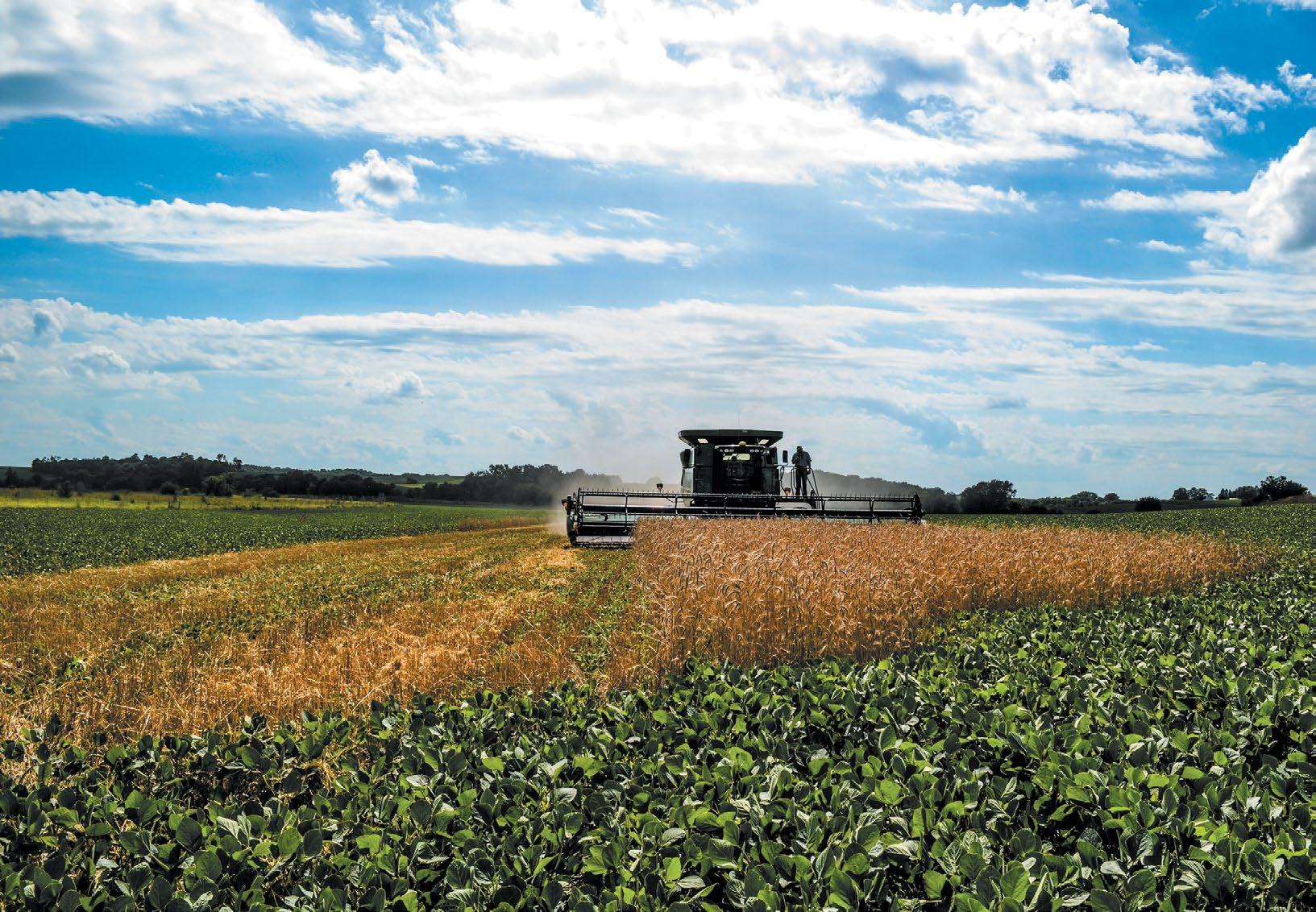
1-YEAR CONTRACTS
The Soil and Water Outcomes Fund provides financial incentives directly to farmers who implement new conservation practices that yield environmental outcomes like carbon sequestration and water quality improvement. Participating farmers typically implement practices including no-till/reduced tillage, cover crops, and extended crop rotations. Already implementing these practices? No problem, you can still enroll with additional practices or acreage.
Small changes can make a big difference. Diversify your revenue stream and enhance your operation’s financial resiliency through improved soil health with the Soil and Water Outcomes Fund.

How Do I Find Out More and Enroll? Visit theoutcomesfund.com to learn more and enroll. You can also use the QR code or send an email to contactus@theoutcomesfund.com

*Enrollment closes once we reach our acre goal for the year.
Are you ready to accept the challenge to be a better-thanaverage soybean farmer?
“ That was a question posed during a soybean meeting I attended. The speaker said farmers who can improve their productivity by at least five percent over average are farmers who will succeed.
While there may be many ways to improve our production plan, one of the first that came to my mind is one we already invest in: the Soybean Research & Information Network (SRIN).
Research is one the primary buckets funded through state and national soybean checkoff dollars. As a checkoff organization representative, I often get asked how our checkoff money is spent and whether it generates return on investment. Unequivocally, I know SRIN is worth every dime. ”

SRIN is a website that was created to share with farmers results from research that is housed in the National Soybean Checkoff Research Database for every state. SRIN representatives read through the research reports and boil down the information for farmers to understand and easily implement on their operations. The site highlights state soybean research programs, profiles key soybean researchers, hosts a YouTube channel of educational videos and farmer perspectives on production challenges, as well as shares diagnostic tools, agronomic tips and pest control recommendations by state and region. Content is constantly added to keep the site fresh and relevant and is supplemented by a timely social media presence and monthly e-newsletter.
David Clark, farmer from Springboro, Ohio

The American Soybean Association’s (ASA) Corteva Agriscience Young Leader Class of 2023 featured three members from the state of Ohio. Dustin and Casey Converse of Richwood, Ohio, and Ohio Soybean Association board member Austin Heil of Kenton, Ohio, were selected to take part in the program.
ASA’s longest-running leadership program, Young Leader was founded in 1984 and continues to set the bar for leadership training in agriculture, identifying and training new, innovative and engaged growers to serve as the voice of the American farmer.
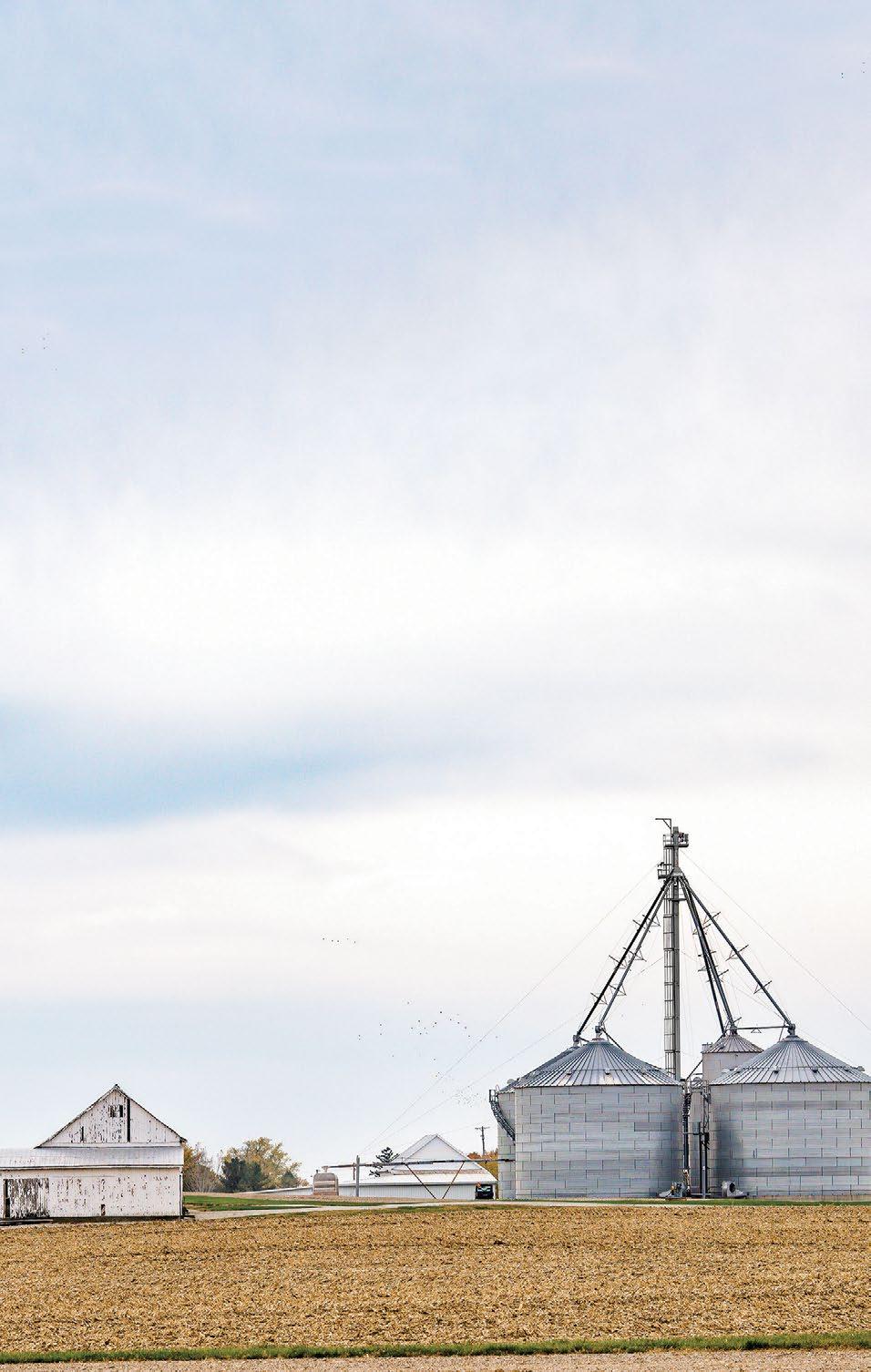

Right now, you need a lender focused on farmers’ futures. As a lending cooperative owned by farmers, we are committed to farmers. That’s why our farmers have received an average 1.5% of their average daily loan balance back in cash for each of the last 4 years through our Patronage* program. It’s our way of supporting our farmers and strengthening their rural communities.
Visit FCMA.COM/PATRONAGE to start a conversation with your local lender.
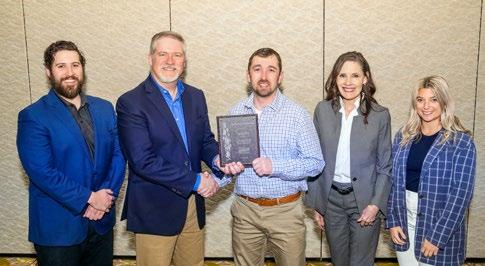
Young Leader not only enhances participants’ skills through leadership, communications, and issues-based training, but also builds a strong peer network, generating increased success in their businesses and communities. Many graduates of this training program assume leadership roles within their state and national soybean associations. Training, open to all ages 21 and up, is interactive and includes evening group activities. Young Leaders are expected to be active supporters of agriculture and participate fully in all training aspects and evening activities.
ASA and Corteva Agriscience worked with the 26 state affiliates and the Grain Farmers of Ontario to identify the top producers to represent their states as part of this program.
Phase I of the 2022–23 Young Leader program took place Nov. 29–Dec. 2, 2022, at Corteva’s Global Business Center in Johnston, Iowa. The program continued in Orlando, Florida, in conjunction with the annual Commodity Classic Convention and Trade Show. Young Leaders were recognized during the ASA Awards Celebration at Commodity Classic and received plaques at the event. u

SOYLEIC® is a non-GMO, high-oleic option for today’s soybean farmers — and those they
• Maturity Groups for Your Area
• Competitive Yields
• Added Value for Culinary and Livestock Markets
That means the future of a healthier food system isn’t manufactured — it’s grown. See why soybean farmers are embracing SOYLEIC®.






American Soybean Association (ASA) farmer-leaders from eight states participated in the Syngenta Leadership At Its Best program Feb. 20–24 in Raleigh, North Carolina and Washington, D.C. Ohio Soybean Association (OSA) board member Trish Cunningham of Union County was selected from Ohio after being nominated by OSA.
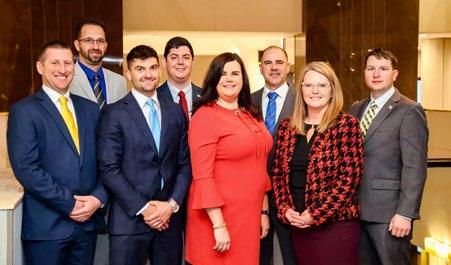
The Leadership At Its Best program, sponsored by Syngenta, provides participants with advanced leadership training and the necessary communication skills to make a difference in American agriculture while advancing into leadership positions on a national level. This results in the creation of a highly-effective collective voice in Washington, D.C., serving the interests of soybeans and U.S. agriculture.
The program is open to current directors or committee chairs of state soybean associations who have a strong desire to assume top leadership positions. Training sessions cover leadership, agricultural issues, communications and media training.
Since its inception in 1991, more than 400 ASA members have graduated from this program.
This year, participants started their week in Raleigh, where they had the opportunity to hear presentations from several Syngenta staff members and tour the Syngenta Crop Lab. In the middle of the week, the group traveled to Washington, D.C., where they developed personal advocacy plans and received
more training on issues and how to effectively carry their message to the Hill from the Washington staff at various
national organizations, including the ASA team. The group also participated in Hill visits with legislators from their states. u

WISHH Chair Roberta SimpsonDolbeare and Treasurer Bob Haselwood honored five young professionals upon their completion of WISHH’s 16-week aquaculture training in Ghana. The May graduates demonstrate how WISHH’s United Soybean Board-supported internship program cultivates innovation and opportunities for the future of fish farming and soy demand in sub-Saharan Africa.
“A highlight of our trip was speaking with aquaculture interns and farmers who are poised to grow their industry. They repeatedly volunteered to tell us why they prefer our high-quality U.S. soy for their feeds,” said Simpson-Dolbeare who is also an American Soybean Association director. “WISHH is strengthening their overall aquaculture industry, which could eventually boost trade for U.S. soy in new markets.”
Haselwood reports, “sub-Saharan Africa is
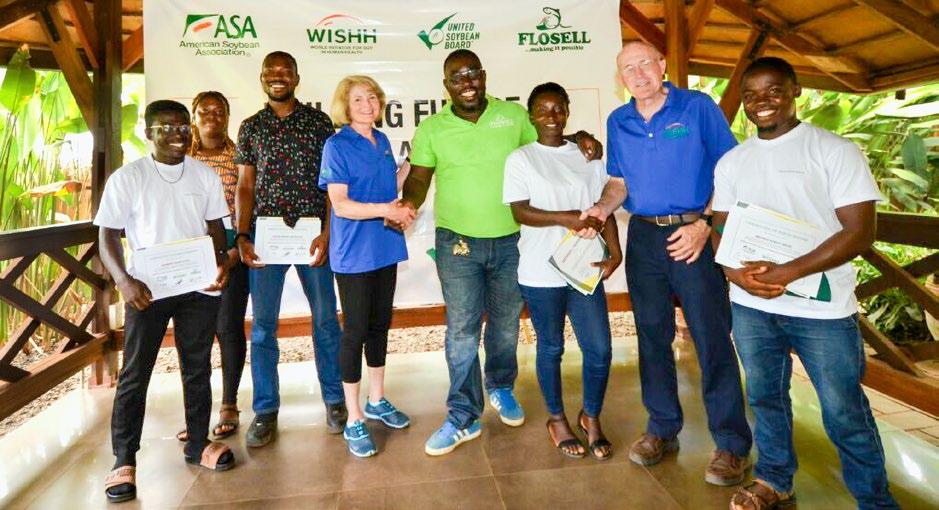

home to talented and hardworking young aquaculture professionals, and they have important natural resources to support future aquaculture growth.”
Flosell Farms hosts WISHH’s aqua internship program in subSaharan Africa.
Owner Evans Danso
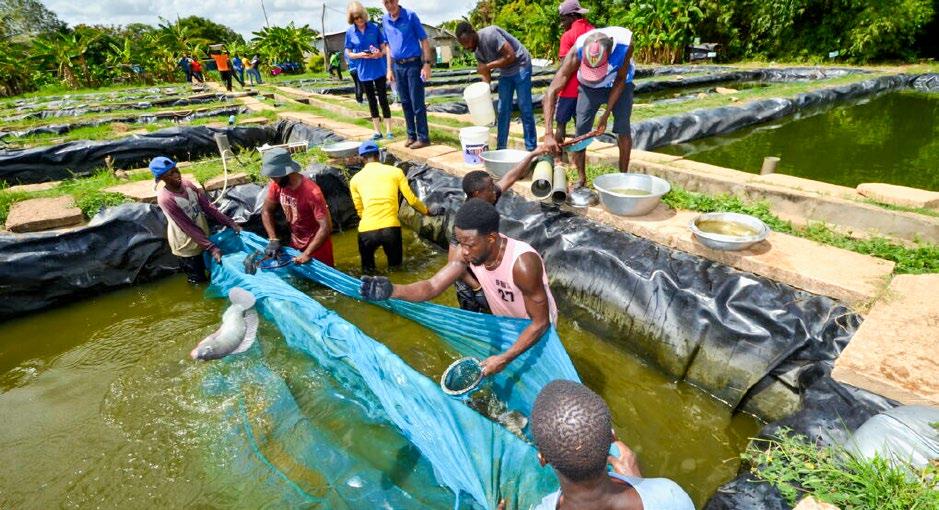
uses 60%-soy feed and produced 16 million fingerlings and 1300 tons of table-sized tilapia in 2022.
WISHH strategic partner Evans Danso hosts the training to give real-world experience. More than 50 applicants from multiple countries competed for spots in WISHH’s spring 2023 training session. WISHH has leveraged its USB aqua internship project with the USDA Market Access and Agricultural Trade Promotion programs.
The hands-on experience is prized by interns like Mbonea Assery Mdoe who traveled from East Africa where he is the co-founder of Aqua-Farmers Hatcheries in Tanzania. “It’s been an incredible journey filled with invaluable experiences, personal growth, and new connections,” shares the entrepreneur who already had five years’ experience and a bachelor’s degree in agriculture. “I’m immensely grateful to the amazing team … Excited to bring these newfound abilities to the next chapter of my professional journey in the aquaculture industry.” u

Launched in 2019, Soy Excellence Centers (SECs) are a U.S. Soybean Export Council (USSEC) initiative creating a global network of tomorrow’s soybean leaders by providing capacity building and workforce training today. These programs operate in five countries, Honduras, Thailand, Singapore, Nigeria and Egypt, and represent four emerging soybean industry markets with the Americas, Asia, Middle East and North Africa, and Sub-Saharan Africa.

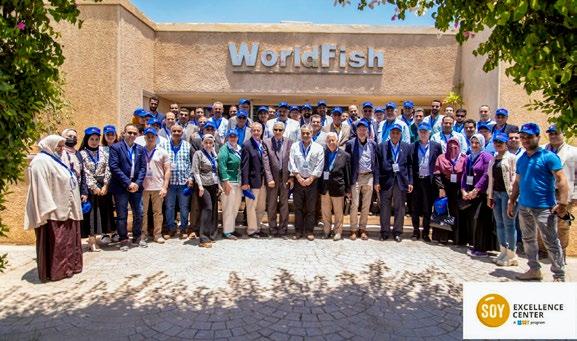
SEC training programs curricula are track-based and focus on five main areas: poultry production, feed milling, aquaculture, soybean processing and swine production.
In 2017, the soybean checkoff invested in a study on its market development programming to increase profits for soybean farmers in the United States from export demand. The research indicated the necessity to increase soy utilization in expanding and emerging markets, and thus the Soy Excellence Centers were born. These SECs aim to turn budding markets into economic success stories by building the capacity of protein enterprises in such markets. It is achieved by facilitating workforce training and continuing employee educational activities to build knowledge and skills to overcome food and agribusiness operations challenges.
The qualified state soybean boards (QSSB) helped establish and promote these Soy Excellence Centers alongside national soybean organizations. The Ohio Soybean Council is one such QSSB investor partner. These SECs continue to serve more than 24 countries and impact over 1,300 businesses, touching more than 7,500 early-tomid career protein professionals with its world-class programs.
The digital SEC platform is building communities for the professionals they serve. For example, about 600 trainees participate in the virtual Poultry Professional Development Community, or the Poultry POD, as they are better known. In this POD,
newly trained poultry professionals connect with peers to exchange knowledge, ideas, and on-the-job expertise. This POD and similar communities for feed milling and aquaculture amplify USSEC touchpoints with trainees as they advance their careers.
Continued access to information and education through the SECs elevates the perception of U.S. Soy and highlights our commitment to providing solutions. Further, the SECs create a high level of attendee satisfaction and relationship building that helps U.S. Soy as a trusted long-term partner.
The SEC program is another way to grow the soybean industry internationally and create more demand for both Ohio and U.S. soybeans around the globe. One that bodes well for all as we work toward creating a more abundant tomorrow. u


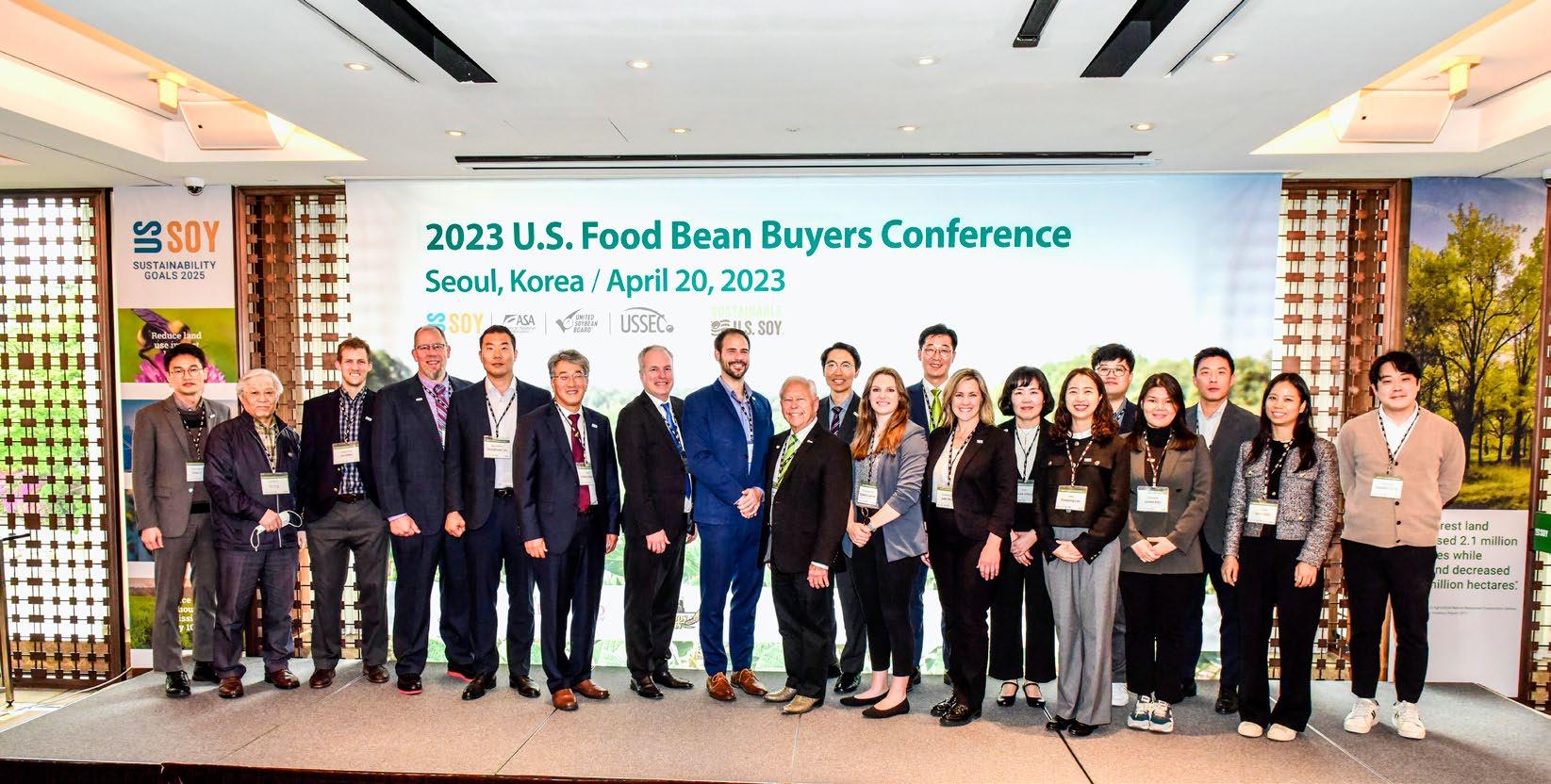
By Madi Layman
This April, Ohio Soybean Council (OSC) Vice Chairman Bill Bayliss and staff member Madi Layman took a brief trip to Asia to talk about Ohio and U.S. non-GMO soybeans for the first time since 2019. In collaboration with the U.S. Soybean Export Council (USSEC), Bayliss and Layman attended the 2023 U.S. Food Bean Buyers Conference in Seoul, South Korea, and the Asia Soy Excellence and Food Summit in Bangkok, Thailand. Bayliss, who is also a United Soybean Board director and a veteran in speaking with international customers, talked about his farming operation in Logan County during each of these conferences. Both events were conducted to connect with soy food industry leaders in the Korean and Southeast Asian regions.
Korea imports 96 percent of its soybeans. In 2022, Korea imported 190,000 metric tons (MT) of U.S.
food grade beans, a 60 percent market share, and 446,000 MT of soybeans for crush, a 45 percent market share. One metric ton is equal to 36.74 bushels. Of the food-grade soybeans imported, 51 percent of those go towards tofu manufacturing, followed by soy sauce, soy paste and soy milk. During their time in Korea, USSEC regional staff organized several factory tours for U.S. representatives to connect with company leaders and learn about the manufacturing and soybean needs of each of these popular products.
The tours began with CJ Cheiljedang Corporation tofu plant. Their tofu business started in 2006, and they are the largest food company in Korea. They buy about 22,000 MT of soybeans per year for tofu and soy paste production. Of that amount, 10,000 MT is for tofu and 8,000 MT of those are from the U.S. The group heard from CJ’s plant manager and viewed their tofu manufacturing building. The production floor was about the size of a football field and housed several large pieces of equipment needed during the tofu making process.
The group also visited Sahmyook Foods’ soymilk plant. Sahmyook Foods holds 30 percent of the soymilk market share in Korea and 95 percent share for export products. The business started with a group of dairy cows from Ohio when missionary George Hailey brought them to Korea. The soybean business was introduced around the same time. The plant has about 1,400 tons of soybean storage capacity but can process some on arrival. Around one million Sahmyook products are purchased daily, and they produce around two million products daily.
The final industry visit was to the soy paste factory of Sajo Industries. Sajo is one of two Korean companies using the Sustainable U.S. Soy (SUSS) logo on their products. Of the 3,000 MT soybeans used in their Sunchang plant every year, 80 percent are from the United States. Sajo Industries received USSEC’s U.S .Soy Sustainability Award in March 2023. During the U.S. Food Bean Buyers Conference, a Sajo representative stated that the SUSS

logo helps to differentiate their paste in a competitive market.
The U.S. Food Bean Buyers Conference welcomed soy purchasers and other industry leaders to engage in conversation about the U.S. soybean market. Market updates were given by several U.S. soybean exporters including The Scoular Company and The Delong Company, Inc., both of which have facilities in Ohio.
Bill Bayliss shared his 50-year-old operation’s story and crop progress update. The themes of sustainability and collaboration were present during this conference as Bayliss explained the importance of sustainability to the farmers and end consumers.
“Sustainability doesn’t just refer to the environment; when we talk about sustainability, we are also talking about economics,” Bayliss shared. “Economics of the farm need to be profitable to sustain it, so we have to talk to and listen when our buyer wants a new product or specific variety.”
The attendees in purchasing roles and decision-making positions were advised to talk with their suppliers as early as possible and begin contracting for next year’s crop to ensure their needs are met.
Bayliss and Layman were accompanied by several other U.S. Soy representatives during the Asia Soy Excellence and Food Summit in Thailand. This
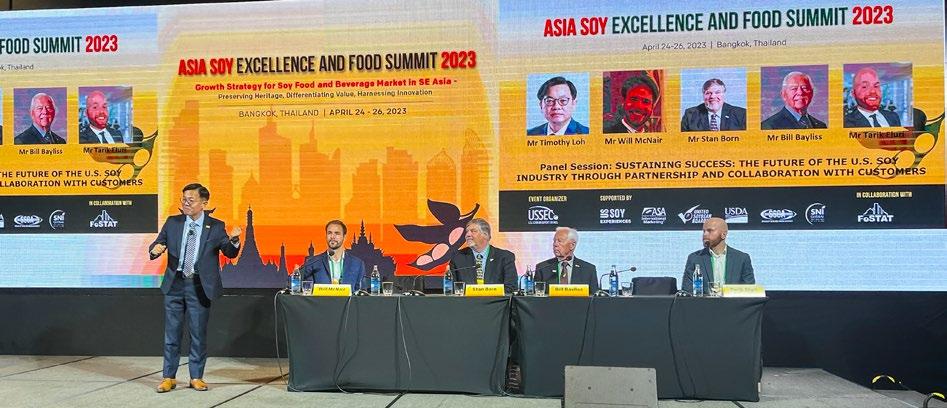
information-packed conference featured around 25 presenters from numerous corners of the soybean industry.
Following opening remarks by USDA Foreign Agriculture Services Agricultural Counselor of Thailand Kelly Strange and USSEC Chief Executive Director Jim Sutter, Bayliss took the stage once again to talk about his operation and sustainable farming. The audience consisted of soy food industry professionals, dieticians and entrepreneurs, so Bayliss took the opportunity to talk about the hard work that goes into growing specialty soybeans.
“It takes extra effort, but gives extra pride,” Bayliss told the audience. “We are human beings, and we rise to the opportunity. We are glad to supply food to the world.”
His presentation was followed by USSEC Director of Oil & Soy Foods Programs Will McNair’s presentation on soy food trends in China, Japan, Korea and Taiwan.
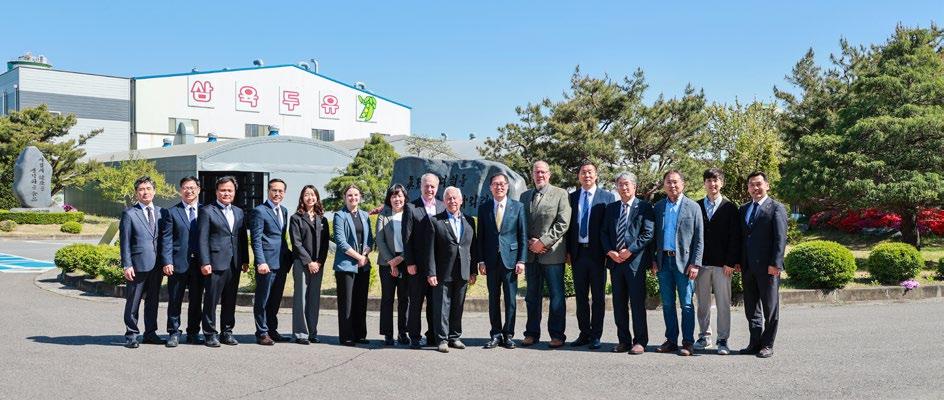
USSEC Regional Director of SEA & Oceania Timothy Loh hosts a “Sustaining Success” panel with (left to right) USSEC Director Will McNair, USSEC Chairman Stan Born, OSC Vice Chairman Bill Bayliss and USSEC Sustainability Manager Tarik Eluri during the Asia Soy Excellence and Food Summit.
These regions import large quantities of soybeans for food use, presenting large opportunities for soy food innovation. According to a presentation from North America Innova Market Insights, one-third of the world’s new food and beverage products were launched in China. Indonesia is the second largest market for soy protein and fastest growing innovation market, according to the same presentation.
The audience then heard from the Institute of Food Research and Product Development on the history of soybeans in the Southeast Asian region. Soybeans were originally cultivated in China in 2800 BC and spread to other Asian countries in 1000 to 28 BC. The first known mention of soy food in Indonesia was during the ninth century. Centuries of soy food has continued to drive innovation in the Asian markets and kept the demand for soybeans high.
Bayliss wrapped up the conferences with an analogy, “A rising tide lifts all ships. Sharing information at these conferences benefits both sides.” u

In 1991, Gunnar Lynum saw an opportunity to support farmers’ connections to international customers, so he founded Strategic Marketing Development, a consulting firm that creates awareness around all the good things happening in the farming industry. Learn more about Lynum’s 55 years in the oilseed business and memories made with international buyers.
What sparked your interest in working for this market?
My training was in food science, but I always had an interest in value-added marketing. My interest was really sparked when I was stationed in Japan working for the American Soybean Association. I did a study where I was shocked to find that IOM (Indiana, Ohio, Michigan) soybeans shipped in bulk and were cleaned in Japan, and this was the lowest cost beans available to the user, yet the beans were four times the bulk price, having passed through first, second, and third tier distributors. I thought in my head, this is not fair for the farmers, as they are working feverishly to make #1 soybeans, but once it goes through so
many layers, they have been reclassed as #2 soybeans with all the value add being taken outside of the farmers’ control. I saw an opportunity for the farmer to benefit by focusing on QCD (Quality, Cost and Delivery).
Does a particular moment stand out when thinking back on your marketing trips? Do you have any favorite memories? I have many years of good memories from my promotional trips to Asia. There are two very different memories that stand out, which I would like to share with you:
(1) After conducting our first press conference in Tokyo, where we introduced the Ohio Food Grade #1 soybean developed by the Ohio State University, I was surprised to receive a faxed order that evening. The order was on Yamaguchi Company letterhead and had four simple words typed on that piece of paper, “I TAKE 10 CONTAINERS.” That was the first order received for the new type of soybean from OSU. The Yamaguchi Company became a major distributor of Ohio food grade soybeans. Unfortunately, a large portion of his business was wiped out during the Fukushima Earthquake and subsequent tsunami. However, he is still a loyal Ohio customer, buying 10-20 containers a year.
(2) When Ohio entered the Singapore (Southeast Asia) market, the largest importer of food grade soybeans was using 100 percent Canadian soybeans. It took us many years of consistently contacting them to be faced with a
new challenge each time. Whether it was subsidized rail freight out of Canada, or favorable Canadian dollar exchange rates, the challenges were high and never relenting. We finally educated him on the importance of quality, and the benefits of consistent protein content. It took many years, but now I just visited him last month, and he proudly told me about his quality, and why he now imports 85 percent of all his soybeans from Ohio. This puts a smile on my face.
How do Ohio soybean farmers benefit by investing checkoff dollars in your company’s expertise?
We are always focused on new business development opportunities and have expertise in the execution of these ideas. I’m happy to say that we probably have contacts in most corners of the world, and this has allowed us to successfully implement a contact program with follow-up industry meetings that help position Ohio as the best source for quality soybeans. Having been in the industry for 55 years, I think we are positioned to provide a cost-effective approach to the market based on common sense and the common goal for providing the customer with the best product. In contrast to a large consulting firm who may provide more graphics and more fluff, we are a low-cost solution with generations of connections, for a high-quality product, the Ohio soybean. I hope the farmers benefit from the ecosystem we have created with the Ohio soybean farmer on top. u
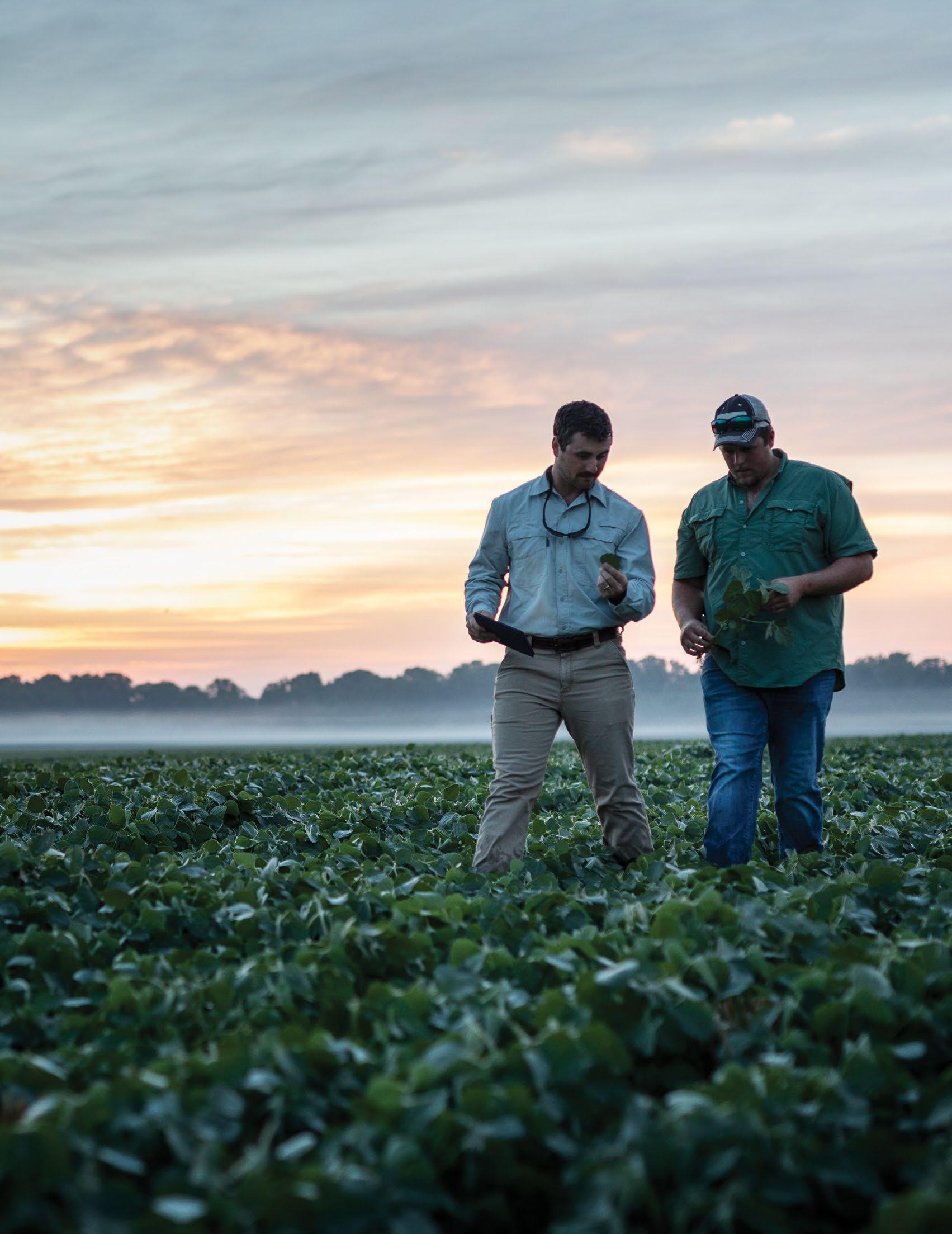

Whether you’re dealing with drought, flood, heat or other climate-related stress, the soy checkoff is working behind the scenes to diversify U.S. soybean genetics and increase stress tolerance. We’re looking inside the bean, beyond the bushel and around the world to keep preference for U.S. soy strong. And it’s helping make a valuable impact for soybean farmers like you.
See more ways the soy checkoff is maximizing profit opportunities for soybean farmers at unitedsoybean.org
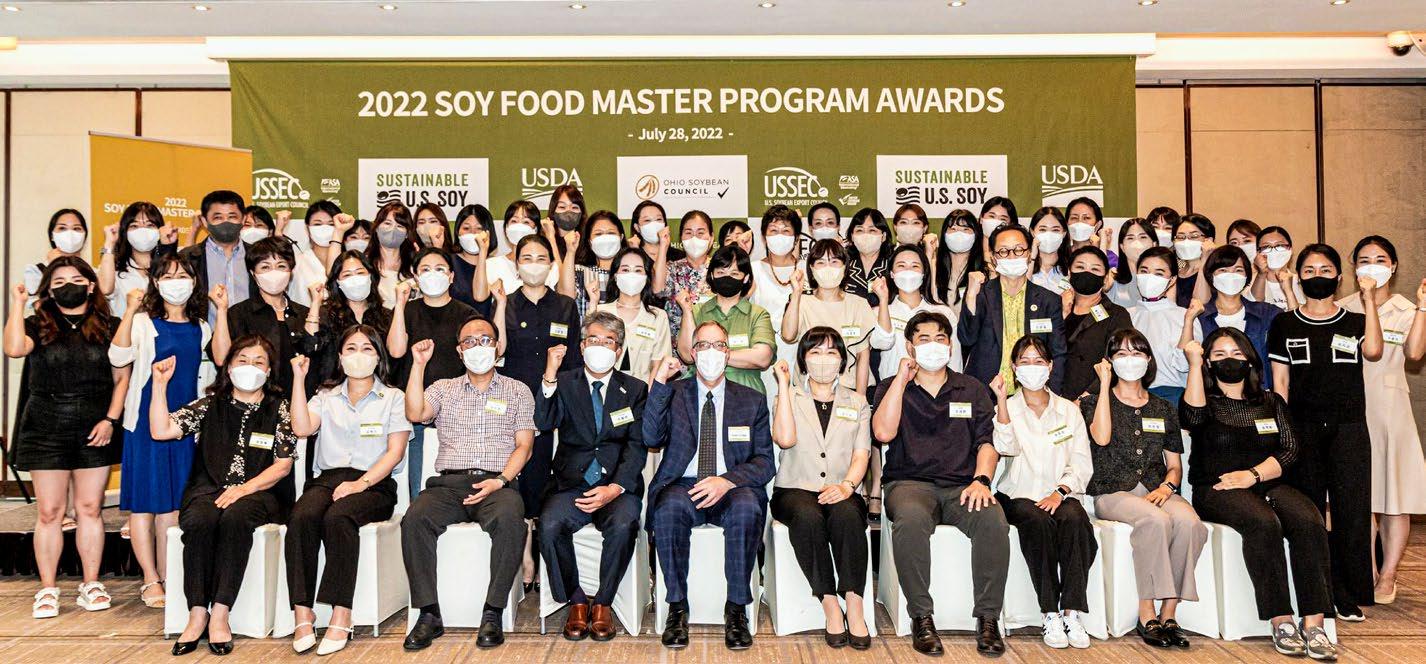
The Soy Food Master Program promotes U.S. soybeans and soy food products and targets chefs and dieticians in the Korean food service industry, with Korea serving as the second largest export market for U.S. food grade soybeans following Japan. Entering its second year, this program is gaining popularity among food service providers. Last year, 122 who applied were honored with the title of Soy Food Masters. This year, more than 200 applied to the program.

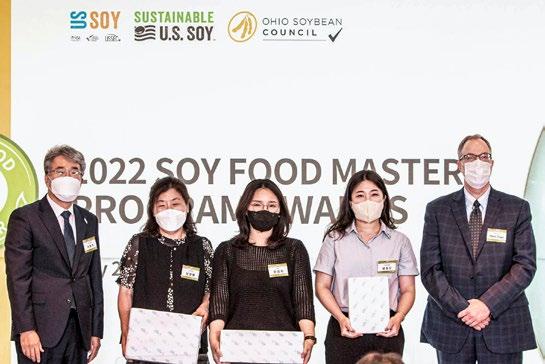
The U.S. Soybean Export Council (USSEC) provides the Soy Food Master Program Guidebook and video lectures to applicants to help prepare for the qualification test. The guidebook covers the health benefits of soy foods and provides soy food recipes developed in Korea, Japan and other countries. Those who pass the test are awarded
the Soy Food Master designation. In cooperation with soy food manufacturers, soy food cooking classes are held in July, and soy food recipes developed for group meals are shared with Soy Food Masters. USSEC hosts the Soy Food Masters award ceremony and soy food recipe contest. Funded by the Ohio Soybean Council, USSEC will host a Soy Food Masters team to Ohio in September to provide them an opportunity to observe a supply chain of U.S. food grade soybeans and learn about the advantages of U.S. food grade soybeans.
Soy Food Masters serve as ambassadors of U.S. food grade soybeans based on what they have learned in the Soy Food Master Program. It is expected that the use of soy food products such as tofu, soy milk, and soy sauce and paste in the food service industry will increase. USSEC continues to update Soy Food Masters on the current U.S. food grade soybean market, health effects of soy and soy foods, and soy food recipes. This will lead to increased demand for U.S. food grade soybeans. u


By Kerrey Kerr-Enskat, U.S. Soybean Export Council
U.S. Soy exports set a record of $40.42 billion in value during Marketing Year 2021/22, which wrapped up last fall. Global customers purchased the secondhighest volume of U.S. Soy to date, 71.79 million metric tons of soy products. One metric ton is equal to 36.74 bushels. That includes the roughly 50% of Ohio soybean production exported annually.
The U.S. Soybean Export Council (USSEC) works to build a preference for U.S. Soy in global markets through a combination of programs, tools and educational opportunities. USSEC helps customers understand the intrinsic value of soy grown by Ohio and other U.S. farmers.

Fish consumption around the world is projected to continue increasing 1.4% per year over the next decade. Aquaculture will need to meet that growing demand for fish and seafood because of the constraints and limits of wild capture. As a result, aquaculture production is projected to increase 36% by 2035.
USSEC consistently shares the advantages of soybean meal derived
from U.S. Soy in feed formulations with aquaculture producers. The sustainability of U.S. Soy is key to aquaculture, both in countries where it is an established industry and as it expands into new regions. In some areas, proven sustainability is a requirement for feed ingredients. The U.S. Soy Sustainability Assurance Protocol (SSAP) verifies the sustainability of U.S. Soy and is accredited by the internationally recognized Best Aquaculture Practices certification. To build preference for U.S. Soy, USSEC conducts trainings and workshops around the world. Our feed specialists support technical experts for aquaculture feed companies and ensure soy feeding demonstrations use best practices. USSEC resources like the International Aquaculture Feed Formulation Database and the In-Pond Raceway System Manual also reinforce the value of U.S. Soy for feeding fish and seafood.

Many soy customers demand proof they are delivering sustainable nutrition and energy. U.S. Soy has the lowest carbon footprint compared with soy of other origins. U.S. Soy farmers produce more while using fewer resources, implementing farming practices that reduce carbon footprints and preserve forestland.
USSEC provides customers with SSAP certificates that can be transferred along the supply chain. The SSAP verifies that soy produced in the United States complies with a system of sustainability and conservation laws and regulations. It is one of the largest sustainability verification programs in agriculture. SSAP has proven to be a highly reliable measure of U.S. Soy farmers’ commitment in areas like biodiversity, sustainable production practices, public and labor health, and continuous improvement of farming practices. Global customers chose SSAP certificates for 59% of U.S. Soy exports in market year 2022. SSAP shipments in 2022 increased 33% compared to 2021.
Companies that verify their soy purchases with SSAP certificates also have the opportunity to use the trademarked Sustainable U.S. Soy logo on their products. This label is now used on more than 900 products made from U.S. Soy around the world.
U.S. Soy has the Lowest Carbon Footprint vs. Soy of Other Origins
U.S. Soy Oil has the Lowest Carbon Footprint vs. Soy Oil of Other Origins
U.S. Soy Oil has the Lowest Carbon Footprint vs. Other Vegetable Oils
U.S. Soy has the Lowest Carbon Footprint vs. Other Sources of Protein
USSEC connects the worldwide soy supply chain to U.S. soybean farmers. All season, USSEC hosts trade teams on farms, at grain terminals, in ports and more. At the same time, USSEC sends trade missions to meet with U.S. Soy customers at home. Ohio Soybean Council leaders regularly participate in these missions.
These opportunities culminate with the annual global U.S. Soy summit, Soy Connext. In 2022, more than 600 buyers and sellers of U.S. Soy met in San Diego. This year, we expect to welcome hundreds of our customers and supply chain partners to New York City from August 21 to 23 for Soy Connext 2023. The conference will cover topics from field-level insights to macro-economics.
Before and after the conference, trade teams will visit soybean fields and supply chain partners around the country.
Through meeting growing market demand, documenting
sustainability, educating the protein workforce, and connecting customers and farmers, USSEC develops a preference for reliable, sustainable U.S. Soy. u
Source: USDA Historical; U.S. Soy Long-Term Forecast, November 2022
23% of all U.S. soybeans shipped by container from 2019-21 originated in Ohio, the second most of any state
Between 2016-21, Ohio soybean exports via container increased by 57%
Columbus, Ohio accounts for 76% of all soybeans exported by container from Ohio to foreign destinations
Indonesia is historically the largest market for containerized soybeans from Ohio, followed by Malaysia and Taiwan
*Information from S&P Global from 2011-2021
By Madi Layman, Manager Demand & Market Development
I
used to think airline crews had the best jobs because they got to travel the world for work and experience different cultures. When I decided to pursue a career in agriculture, I never would have guessed that I would be one of those people who visited the other side of the world.
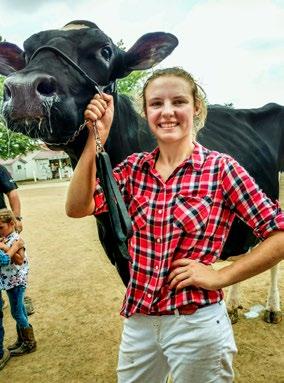
My agriculture background is in dairy. My family milks 250 cows, two times a day, seven days a week, 365 days a year. The milk is sold domestically to an Ohio company known for their awardwinning baby Swiss cheese — maybe you have heard of them.
Growing up, my siblings and I participated in 4-H and our high school’s FFA program. Agriculture had a big impact on my life and the career path I chose.
When I joined the Ohio Soybean Council team in 2021, my role as communications coordinator required me to work with everyone and relay important project updates to the farmer stakeholders. In doing so, one area that sparked my interest was seeing how Ohio soybean farmers were marketing their soybeans to international markets. After hosting two trade teams in 2022 and seeing how our farmers interacted with these major buyers, I decided this is an
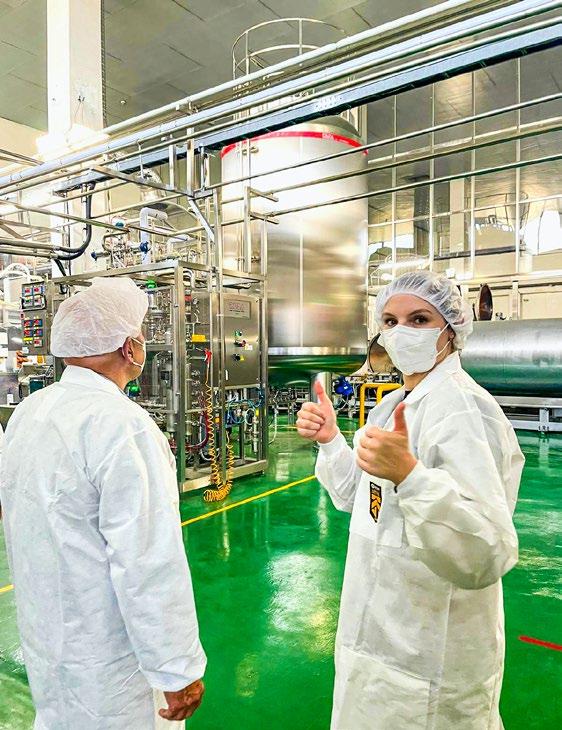
area I wanted to explore more and contribute to.
Ohio is uniquely positioned to market its soybeans in several areas — commodity soybeans, specialty soybeans and meat exports. During the 2021/22 marketing year, 41 percent of Ohio whole beans were exported to foreign markets (namely China). Your checkoff makes investments to continue relationships with
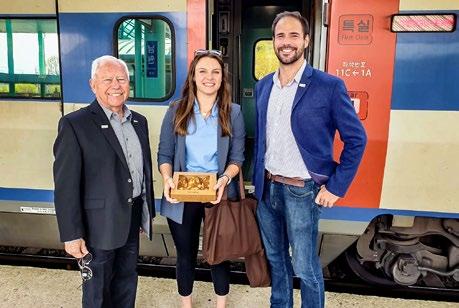
these markets and even expand into new markets.
Ohio also has ideal soil and climate to grow highprotein beans used for the soy foods market in Asian countries. Ohio usually ranks within the top five states who grow the highest percentage of soybeans designated for soy food markets. Therefore, farmers can diversify their crops and collaborate with new customers.
Finally, Ohio soybeans enter international markets through meat products. The Council works with the U.S. Meat Export Federation and U.S.A. Poultry and Egg Export Council to promote consumption of U.S. meat, which indirectly promotes the consumption of Ohio soybeans. In 2022, U.S. pork exports accounted for 5.91 million bushels of Ohio soybean usage.
All of this is to say that the Ohio Soybean Council’s international marketing program builds relationships and takes American agriculture to places most people wouldn’t think of. I now communicate beyond the domestic consumer and student, and connect with international buyers, company leaders and other key decisionmakers. When I get home, I explain why I was in Korea and Thailand for two weeks to my friends and give them a snippet of all the places agriculture exists. u














“Through the Soybean Council and as an Ohio soybean farmer, I am proud that we’re helping feed the world.” -CINDY LAYMAN, SOYBEAN GROWER KENTON, OH








